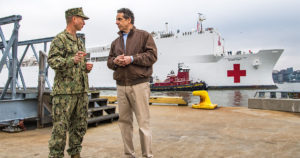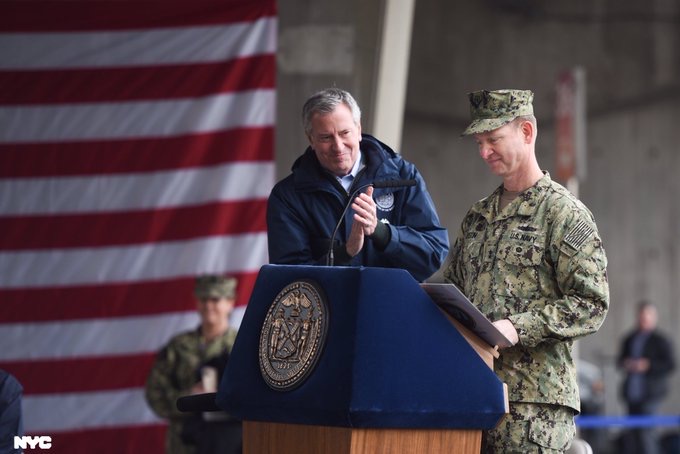Bringing Comfort to New York City
Wherever disaster strikes, from Haiti to Puerto Rico to New Orleans, the U.S. Navy hospital ship Comfort is often there.
“That unmistakable white hull—that is a symbol known around the world,” says Rear Adm. John Mustin MBA’06, who has served in the Navy for 30 years. “It is a very visual symbol of hope and comfort and resiliency.”
In 2001, Comfort came to a reeling New York City in the aftermath of the 9/11 attacks. Now, nearly 20 years later, Mustin oversaw the effort to bring the Comfort back to New York City in response to the pandemic.
Preparing the ship to set sail required lots of logistics and teamwork. Scheduled maintenance on the Comfort had to be wrapped up, 1,200 doctors and nurses were brought in from around the country, and pallet upon pallet of equipment were loaded aboard. A New York pier even had to be dredged to make sure it was sufficiently deep enough for the 70,000-ton Comfort, which used to be an oil tanker before being converted into a hospital ship.

Rear Adm. John Mustin MBA’06 with New York Gov. Andrew Cuomo
All of these efforts by so many illustrated the shared sense of purpose that Mustin has long enjoyed in the Navy. “What is most inspiring is being around people who work so hard and are so amazingly talented,” he says. “We are contributing something that is important to the nation.”
A Family Tradition
Mustin comes from a family full of Navy tradition. He is the fifth generation to attend the Naval Academy, and, through the years, the Mustin name has graced two Navy destroyers.
Growing up, Mustin remembers listening to older family members and family friends recounting their military experiences at gatherings. “It was great to be in the company of these folks,” he says. “I was always marveling at the stories they would tell. It’s the stuff they make movies about now.”
Bringing the Comfort to New York was just the latest accomplishment in Mustin’s long Navy career, the last 19 years of which have been spent in the Navy Reserve. Six times he has served as a commanding officer, his commands ranging in size from 55 to 25,000 people.
As of late March, the current stop for Mustin is at U.S. Fleet Forces Command, which is responsible for the preparedness of a large portion of the U.S. fleet, including those ships based on the East Coast. “We ensure that naval forces are prepared to deploy around the world,” he says. “It is an extensive portfolio of responsibilities.” As vice commander at U.S. Fleet Forces Command, Mustin is tasked with supporting the mission readiness of the fleet, as well as ensuring that the Navy’s Reserve force of 58,000 is structured, trained, and employed effectively.

Rear Adm. John Mustin MBA’06 with New York City Mayor Bill de Blasio
While the Navy is one of the largest organizations in the world, Mustin warns against making assumptions about the agility of its operations. “It’s easy to paint a Department of Defense entity with a broad brush and say, because they’re large, that their thinking and processes must be bureaucratic,” he says.
Being forward thinking and having an agile mindset are two traits that actually are highly valued in the Navy, he says. “The people who succeed there apply and really embody the idea of agility and being nimble and understanding how to pivot,” he says.
A Way of Thinking
Mustin was able to hone these skills in a place seemingly far removed from the Navy: Babson College. He admits he felt a bit unsure when he started at the school, a not uncommon feeling for those with a military background. Yes, he obviously knew about leading people, but he felt his Navy expertise didn’t necessarily have tangible applications in civilian life. “If you want to shoot Tomahawk missiles, I’m your guy,” he says, “but if you wanted to talk about sales plans, I would have been lacking.”
“What is most inspiring is being around people who work so hard and are so amazingly talented. We are contributing something that is important to the nation.”
Rear Adm. John Mustin MBA’06
Mustin also faced another challenge: In the middle of his Babson education, he was suddenly deployed. “I took a year off to live in a tent in Kuwait,” he says. “I jumped right back in when I returned.”
Despite the challenges, Mustin says the way of thinking he learned at Babson continues to serve him well, whether he’s preparing a hospital ship for a vital mission or working on Wasabi Rabbit, a marketing communications firm he started. “I can think about a problem in the right way and ask the right questions,” he says. “It has been a huge enabler for me, both for my Navy career and my civilian career.”
Posted in Community





